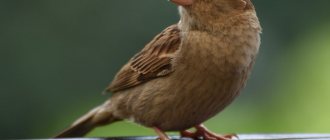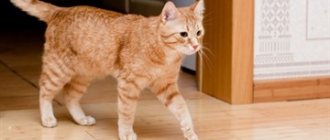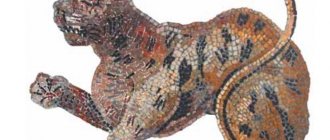Have you ever thought about the meaning and origin of such familiar words as "cat"
and
cat"
?
Surprisingly, in almost all Indo-European (and not only) languages the name of this long-time friend and companion of man sounds almost the same
and has a root base KAT-CAT, less often - GAT (English - cat, German - katze, Spanish - gato, French - chat, Polish - kotka, Lithuanian - katinas and kate, Armenian - k'at'u, Irish - catt, Arabic - kyit, Afrikaans - keht, Indonesian - kutjin, Africans - keht, etc. d.)
According to the most common etymological versions, this word was borrowed either from the North African (Nubian) - kadis, or from the Latin - cattis (it is noteworthy that domestic cats are also called felis in Latin). This is consistent with the old theory that cats were first domesticated in Egypt and North Africa, from where they then spread throughout Europe through the Roman Empire.
Fresco, Egypt
However, recently this hypothesis has been subject to serious criticism - new found remains of cats in burials in Europe (Germany) date back to the 2nd millennium BC. e., and in Crete even - the 9th millennium, there is evidence that in Asia cats were domesticated many millennia ago. And the latest genetic studies of the DNA of wild, domestic and feral cats from several continents show that their spread across Europe occurred in two waves - the first in the 12th–9th
millennia BC. e. came from the Middle East, and the second came from Egypt.
And if so, then perhaps there is no point in looking for which language the word “kat-kot” was “borrowed” into all others; it is much more reasonable to recognize that
this word comes to us from a single ancient Indo-European proto-language .
Wild forest cat
That is, no one ever borrowed it from anyone - it was always “with everyone” - the only question is how to interpret it. And we can easily read it
in Russian
. Despite the sarcasm of representatives of official linguistics and etymology, who consider this approach unscientific, many native Russian words are perfectly “read” using the Russian syllabic alphabet of meanings, intuitively understandable to every speaker of our language without the need to resort to any established rules or taken “on faith” » postulates.
This does not mean at all that the word cat-cat and others were “borrowed” by all other languages from Russian, it’s just that our language, apparently, has changed less than others and has moved away from a single root. The best proof of this is the incredible closeness of our roots with Sanskrit (the “dead” ancient language of India, which, like Latin, is no longer spoken) and the ability of Sanskritologists from India to understand Russian speech - especially northern dialects - without translation at all. That is why many words that are equally “native” for all Indo-European languages reveal their meaning and are “read” in Russian (and Sanskrit).
For example, as many people know, the syllable “ha” corresponds to an image of movement - teleGA, noGA, GAt, doroga, pokerGA (needed to stir the coals), GARMON (the sound arises due to movement), trampGA... And, for example, taiGA is the end of a known road or familiar world, something unknown, where roads have not yet been paved - that is, a secret road... Or, say, the syllable “ra” corresponding to the image of the sun: DAWN (= “light of the sun”), JOY (= “enough light”) , MARA in the sense of “obsession” (= “death/pestilence of the sun”)...
It is an amazing coincidence (or not?) that the surname of the first cosmonaut Yuri Gagarin can, according to the above images, be interpreted as “double/accelerated movement towards the sun” GA-GA-RA. And you can’t argue with that either.
Let’s try to read the word “cat” using the syllabary alphabet of meanings and see what and who it was in the everyday and mythological world of the ancient Slavs.
Origin, etymology of the word “cat” and the word “cat” in Russian
Let's start with the fact that in Russian there are two designations for this animal, depending on its gender, quite different in sound - “cat” and “cat”. Moreover, similar pairs, not close or very distant in sound composition, are in the Russian language to designate most domestic animals:
cow and bull, ram and sheep, dog and dog, horse and horse, rooster and hen, drake and duck... All these are fundamentally different words that capture some fundamentally different semantic meanings - this is not at all like “elephant” and “ elephant" or "tiger" and "tigress". Some other languages, especially Slavic, also have this phenomenon, but in general, not all Indo-European languages have such a variety of words, which is another indirect proof of the greater proximity of the Russian language to the proto-language (more words - fewer simplifications and generalizations).
M. Shrilev. Darenka's dreams.
Returning to the cat and the cat - it is impossible to say which of them is primary or more important from an etymological point of view. Therefore, we will consider separately both “cat” and “cat”.
Version 1
CAT. The first syllable “ kosh/kosh” indicates extreme antiquity.
Let us recall other words
“KOSHCHEY”
(Immortal),
“KOSCHUN”
(= “history, fairy tale”),
“KOSCHUN/KOSCHUNNIK”
(= “storyteller of ancient legends.” When these were banned, the word “blaspheme” acquired a different negative meaning).
Another semantic group is words associated with preserving, saving something (which is also one of the semantic series in words like “blasphemy” / fairy tale - as the preservation of knowledge and legends through their transmission): KOSHt, KOSHEL / KOSHELEK, KOSHMA
. The same KOSHCHEY “languishes over gold,” that is, he preserves it, protects it.
The second syllable “ka” reflects the image of the soul
(or in more complex interpretations - one of the levels of subtle etheric bodies).
That is why diminutive names and abbreviations are formed using this syllable: AlenKA, Irinka, VadimKA... hut, rolling pin, gingerbread, pechka
.
By adding such an ending to a name, we seem to address a person more “warmly”, “addressed”, “closely”, as if we are touching his soul, and not just calling, and by adding -to the object we partly animate him, endow him with some unique form and even independence
. It’s not a hut, and it’s the hut that turns on chicken legs “back to us in front of the forest”, the self-assembled tablecloth itself will set the table for us, and the stove standing in the middle of the field will itself bake pies and protect the brother and sister from evil geese and swans...
It turns out that CAT is an “ancient soul” or
a “guardian soul”
! And isn’t this what we read in the calm, wise and bottomless eyes of this seemingly unearthly creature? By the way, in a variety of religions, cults and countries you can find legends about the extraterrestrial origin of cats, directly indicating that they came to earth from heaven:
- In Ancient Egypt, it was believed that cats came to earth as companions of the gods, so in Egyptian wall paintings they are also often depicted with wings. Cats were deified and considered sacred animals - temples were built in their honor, they were allowed into closed/secret rooms of sanctuaries, where entry was closed even for priests (but at the same time there were small doors so that cats could pass through - THE SAME IN RUSSIA in some old Vladimir and Suzdal churches
), after death they were embalmed, mummified and preserved as noble nobles or pharaohs. There was a cult of the goddess of happiness Bast with the head of a cat. - In Peru, there are a number of cave paintings depicting aircraft, reminiscent of photographs of UFOs, and next to them...cats with wings.
- Christian author Augustine the Blessed called cats “inhabitants of the Heavenly City,” the only creatures who are allowed to know the way there and back.
I. Bilibin. cat scientist
What about “cat”? In The Tale of Bygone Years it is designated a little differently as “kotka”
, in children's lullabies it also often appears under the designation
“kitten-cat”
, which means that
everything that was written above regarding the part -KA (=soul) equally applies to it.
It remains to deal with the root “CAT”
.
Apparently, it also indicates not some kind of “preservation”, “saving”, “sheltering” of something inside ”
, like the root “KOSH”, and sometimes “fixation”, “anchoring”.
KOtomka, KOtel, KOTLOvan, KOTA
(a quadrangular yard made of stakes, surrounded by a net, the fish that enters there is selected from above - from Dahl’s dictionary),
KOTTva
(f. old. anchor; cat, verp, anchor. - from Dahl’s dictionary),
KOTrakh
( hat - from Dahl's dictionary),
CATS
(umad. cats m. pl. women's shoes, a type of ankle boots, boots, shoes with high fronts; men's outer shoes, galoshes, kengas, worn over boots or shoe covers; | master pistons or birch bark bast shoes , with fees - from Dahl's dictionary).
It is interesting to look at similar sound combinations in Sanskrit.
So, the root “kosh” could not be found there, but
“koti” is “edge, ray, ten million”
, and
“kotisah” is “ten thousand millions”
(as an expression of the innumerability of something - see Sanskrit-Russian Dictionary by N.P. Likhushina). So, an indication of multiplicity, infinity returns us to the already discussed syllable “KOSH”, denoting transcendental antiquity. It turns out that the semantic content of the words “cat” and “cat” are, in general, extremely close - this is an “ancient guardian soul”, but perhaps the cat has slightly greater energy, direction, activity, characteristic of the masculine principle - like a ray or tip. Isn’t that why in Russian fairy tales the CAT always acts (!), and in proverbs and signs both cats and cats are found.
Version 2
There is, however, a more “down-to-earth” version, also based on the syllabic reading of the word “cat” / “kotka” as originally Russian. According to it, “kosh” is a camp or part of a district/district, as well as a convoy, a string of carts
(note, the nomads in the carts here are us, not the mythical Tatar-Mongols), and
“ka” is a kind of living entity
, which is consistent with the interpretation of “soul,” although on a more simplified plane of perception.
It turns out that KOSH-KA is “resident of the camp, convoy,” “one who lives inside the camp/convoy
.
Version 3
Alexander Uglanov. Makosh
Another series of interesting semantic associations can be derived from the name of the key goddess of the Slavic pantheon - Makosh/Mokoshi
.
In her name we again see the root KOSH (and, of course, the initial syllable MA, obviously denoting Mother, Woman, Feminine). Being the patroness of all women's, i.e., household affairs and the keeper of the hearth, Makosh was also responsible for family wealth and prosperity
(filled koshes/wallets),
and comfort
(isn’t this where the word oKOSHKO comes from - as an image of home comfort, what’s inside/ on the other side of your home?)
Cat,
in this context, it is
Mokosh’s assistant
and , again,
a guardian animal that lives inside the house,
and in general is also responsible for the wealth and prosperity of the family,
physically protecting
it
from mice and rats
- the enemies of the harvest,
and on the subtle - from evil spirits, troubles and the evil eye
.
The image of a cat (cat) in Russian folk tales
The cat is a storyteller, he is also a desired treasure
The most striking fairy-tale image of a cat in a Russian fairy tale is Cat Bayun
from the fairy tale
“Go there I don’t know where.”
Here he
is the object of the search, a kind of miracle and at the same time an impossible (almost) task given to the main character
. By the way, Bayun (from the word “bayat”, that is, “to tell”) in different versions of this fairy tale is either the cat’s personal name, or is written with a hyphen with a small letter, that is, it simply indicates his gift as a storyteller.
In general, this is one of the most unusual tales of Russian folklore.
, which seems to exist on its own or comes from a slightly different source than most of the stories we are accustomed to from childhood.
To begin with, the main character here is in different versions - Andrei the Sagittarius , Fedot the Sagittarius, soldier Tarabanov or a merchant's son nicknamed Bezdolny, but never (!) Ivan the Fool or Tsarevich
. Most often he is a royal hunter, supplying game to the sovereign's table. Another “unusuality” is that the hero gets his beautiful wife not at the end of the story, as some kind of reward, but at the very beginning - for no reason at all, then the plot is built around the fact that Sagittarius has to carry out more and more difficult tasks for the king, who simply wants to drive him away from the world in order to marry Princess Marya himself.The tasks vary in different versions of the fairy tale (for example, go find out how the king’s dead father lives in the next world, get golden horns for a deer, golden horns for a goat, a magic mare...
), .
Usually there are three of them and the most important and difficult is the last one - “I don’t know what.”
In fact, the situation becomes even stranger when it turns out that this “I don’t know what” is
an invisible helper or force... named “matchmaker Naum”
!
In other versions it is "Shmat-razum" , "Saura" or simply Nobody.
None of these names appear in other Russian fairy tales.
Andrey the Sagittarius
and the cat Bayun.
Illustration for the fairy tale “Go there - I don’t know where.” In the version recorded by Alexei Tolstoy, one of the royal tasks is precisely the extraction of the bajun cat. The danger of this enterprise lies in the fact that the cat can charm anyone with its fairy tales and send them into an uninterrupted
slumber .
It is noteworthy that
he sits on a high iron pillar, far away in the distant kingdom.
To catch the cat, the shooter, on the advice of his wife, takes with him
three iron caps, three rods and pincers
- the caps protect the hero from the cat's claws, and with the pincers he pulls him off the post.
Soon the fairy tale is told, but not soon the deed is done -
Andrei the shooter to the thirtieth kingdom. Three miles away, sleep began to overcome him. Andrei puts three iron caps on his head, throws his arm over his arm, drags his legs over his legs - he walks, and then rolls around like a roller. Somehow I managed to doze off and found myself at a high pillar.
The cat Bayun saw Andrei, grumbled, purred, and jumped from the post on his head - he broke one cap and broke another, and was about to grab a third.
Then Andrei the shooter grabbed the cat with pincers, dragged him to the ground and started stroking him with the rods...
It is interesting that although at first the cat fights with the hero tooth and nail, but, recognizing himself defeated, he completely loses his hostility and, of his own free will, follows the shooter to where he is leading him.
G.S. Zubkovsky. Cat Bayun on a pole. 1951 “Go there, I don’t know where, bring something, I don’t know what.”
In one of the versions of the tale as recorded by Afanasiev
(No. 215 from volume 2), and in total he has four of them -
ot -bayun is the last building, that is, even more complex than “I don’t know what”
, it is with its capture and taming that the fairy tale ends.
Moreover, the cat here is not a passive object, but an active character
who ultimately helps the archer defeat his enemy - the royal governor.
They walked and and
walked and walked and got where they needed to be; come to the palace, the king saw the cat-bayun and orders: “Come on, cat-bayun ! Show me more passion." The cat sharpens his claws, he gets along with the king; wants to tear his white chest apart, take his living heart out. The Tsar was frightened and began to beg Bezdolny: “Please calm down the bajun cat ! I’ll do anything for you.” - “Bury the governor alive in the ground, now I’ll eat a lot.” The king agreed; They immediately grabbed the governor by the arm and leg, dragged him into the yard and buried him alive in the cheese. And Bezdolny remained to live under the king; the cat-bayun obeyed them both, no one waited on them, and they lived long and cheerfully. That's the whole fairy tale, you can't say more.
The author of the painting is unknown.
The image of the scientist cat Alexander Sergeevich Pushkin, apparently, goes back precisely to such fairy tales about the magical story teller of the cat Bayun.
There is a green oak near the Lukomorye;
Golden chain on the oak tree:
Day and night the cat is a scientist
Everything goes around and around in a chain
;
He goes to the right - the song starts,
To the left - he tells a fairy tale...
Cat - navigator
In some Russian fairy tales, a cat makes a cameo appearance when
one of the characters (a young girl/woman, Ivan) gets lost in the forest.
Here the cat acts as a savior, showing the way out of the thicket . He is initially friendly towards the main character, helps him on his own initiative and completely disinterestedly, and then disappears. After it, two more animals can come to the hero’s aid (which forms a canonical threefold repetition of the event), one of which is usually a gray wolf.
Earth cat. Author unknown. The earthen cat is found in Ural legends, according to which it points to treasures buried in the ground.
This image often includes cats from more “children’s” instructive stories,
in which only animals act and there is no Ivan, no girls, no Baba Yaga, no Koshchei.
For example, “The Cat and the Rooster,” where the cat saves an unlucky rooster from the clutches of a fox who kidnapped him
:
Brother cat!
The fox is carrying me
For the dark forests
For the high mountains
Into a deep hole
Help me out!
The cat is a companion of the otherworldly
Finally, the cat - usually black - is
Baba Yaga's
.
In these fairy tales, he is not an active character in principle, he simply exists, as some kind of integral attribute. That is, here he is a companion of some otherworldly force, capable of easily walking between worlds
. This clearly follows from the very image of Baba Yaga, who is on the border, at a crossroads - half alive, half dead (“bone leg”). It is interesting that in most Indo-European cultures, any asymmetry indicates partial belonging to the other world (blindness in one eye, lameness, etc.). In addition, in some Russian fairy tales there is a direct indication that Baba Yaga’s hut stands on the Smorodina River, separating the world of the Dead from the Living.
In this regard, it is important to note that belonging to the other world in itself is NOT at all
something “creepy” or “bad”
, because not only monsters live in Navi, but also deceased ancestors, that is, friends and intercessors. However, Baba Yaga herself is neither a uniquely positive nor a uniquely negative character. In some stories, she can kidnap babies with the aim of eating them, and in others she already helps the main character, giving valuable instructions and objects.
Another otherworldly character associated with a cat is the brownie
. Folk legends indicate that the cat sees him perfectly, communicates with him and is a faithful assistant to the home guardian.
It was believed that cats and all other otherworldly entities could see - mermaids, goblin, devils. Is this the reason for the strange hissing of pets at empty corners, often observed by their owners?
Vsevolod Ivanov. Brownie
The cat lulls babies to sleep with lullabies
Finally, the cat is the most common character in children's lullabies.
It is kittens who are invited by mothers to the cradles of their babies to rock them, sing sweet songs to them and guard their dreams.
Kitty-kitten , cat,
Kitty's gray pubis,
Come and spend the night with us,
Rock my baby.
It seems that it could be simpler and more logical? After all, the cat is essentially the only pet in the house in the full sense, and besides, it has the excellent ability to purr soothingly. But perhaps our ancestors understood the essence of things much better than us - and cats were invited to children’s lullabies also because the vibration frequency
when a cat purrs (from 20 to 150 Hz)
has a healing effect
- this is the frequency range used today in medicine for physiotherapy treatment. By the way, scientists don’t know how and why cats purr.
The author of the picture is unknown
Is it true that black cats bring bad luck?
In the medieval Vatican, cats were considered assistants to witches, so they were often burned along with their mistresses. Later, in the 19th century, black fur hats became fashionable, so Chinese entrepreneurs caught these animals in order to get rich.
It's true that black cats bring bad luck:
- Nowadays, many signs and superstitions are also associated with black cats. In our country, there are two common opinions regarding black cats. Animals will help avoid theft and bring material well-being to the owner.
- It is believed that if a black cat crosses the road, it will be bad luck. However, this is considered not only in our country, but also in European countries. In Asian countries, as well as Switzerland, black cats are considered companions of success, good luck and prosperity.
- If a girl who is about to get married meets a black cat, this promises a long marriage. In addition, it is necessary to groom and cherish such animals and constantly feed them. This way, the animals will be able to thank you and bring you material well-being.
Cat
Many interesting articles for breeders can be found on our website:
- Is it possible to give cats human tablets, No-shpu, Valerian tablets?
- What can you feed a 1-6 month old kitten without a cat and how many times a day: list of feeds, products and dishes, feeding regimen
- Is it possible to leave a cat alone for a day, 5 days, a week, two weeks?
- Why does a cat itch and lick itself, but there are no fleas? The cat is constantly itching: causes, methods of treatment
There is no need to be afraid of black cats, since, unlike animals with the usual color, they are magical creatures and often help their owners. Oddly enough, the black cat has nothing to do with demons and entities that want harm to people. On the contrary, they are very friendly animals that love their owners.
Cat and cat in the rituals and signs of the ancient Slavs
Combining all of the above into a single picture, we can finally highlight the key abilities of a cat, to which our ancestors attached special importance:
1. ability to purr/tell stories/lull to sleep
- which in folklore is much more important than such a utilitarian function as catching mice. What kind of stories cats tell and why is an open question. Are they healing us? Do they store some encrypted knowledge? (remember the root basis “kosh/kosh”)? Is their fairy tale a sound key for entering the “open field”, “prophetic forest” or noosphere?
2. the ability to “see” something inaccessible to people, otherworldly
- hence the cat’s ability to find the right path, warn and protect its owners from evil spirits.
Maria Molodykh. Painting
That is why:
- “It’s not a hut without a cat” and the cat is the first to be allowed into the new home;
- Kill a cat - no luck in anything for seven years;
- The first meeting of a person in the next world, according to popular belief, will be with a cat - if he treated them poorly during his lifetime, he will not see any good in the other world.
- The cat's behavior predicted the weather and the arrival of guests;
- A cat was valued more than a cow! For its theft, the 14th-century Metropolitan Court Code stipulates a fine of 3 hryvnia, the same as for an ox (for a goose - 30 kn, for a crown - 400 kn);
- You cannot buy a cat; it is customary to exchange it for something symbolic.
______________________
We didn't get out of the trees. We come from the stars. But no matter how far into the depths of thousands of millennia the history of stellar proto-humanity extends, the history of the cat tribe is probably an order of magnitude older. It is for this reason that our ancestors, having once met with this incomprehensible but friendly mind, gave it the respectful name “cat” - “ancient soul”, “guardian soul”. And they invited him to continue the journey together - as a healer, navigator, protector from dark entities, keeper of knowledge and, of course, Friend.
In the dictionary D.N. Ushakova
CAT, cats, female 1. Female cat. The cat caught the mouse. The cat meows. The cat scratched the child. Angora cat. 2. Cat fur (unfolded). I bought a cat for my collar. 3. prem. pl. Genus of mammals of the cat family (zool.). 4. A small anchor with three or more legs. Fishermen throw away. 5. Shoes with sharp spikes for climbing poles. | The same goes for walking on glaciers. 6. ***** or scrapers (tech.). | A type of fork is a tool for pulling out nails by the head (tech.). 7. only plural Belt whip with several ends, used. for corporal punishment (·ist.). • A black cat ran between someone (colloquial) - trouble began, friendly relations were upset. Cats scratch someone's heart (colloquial) - about a melancholy state, anxiety. Tattered cat - see tattered" title='what is tattered, the meaning of the word tattered in Ushakov's dictionary'>torn. Like a cat and a dog (colloquial) - in an extremely hostile relationship. Like a mad cat (thrashing about, running, etc.; colloquial · disdainful) - in a frenzy, senseless.











